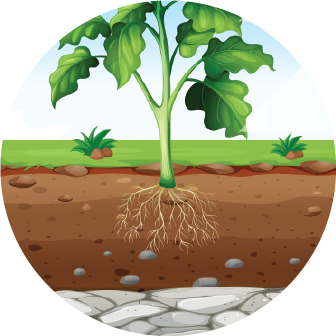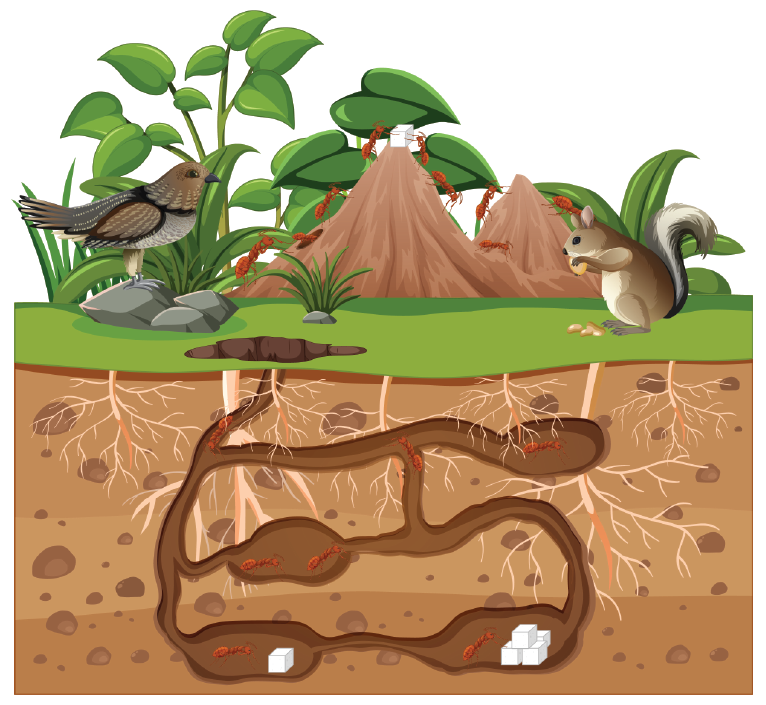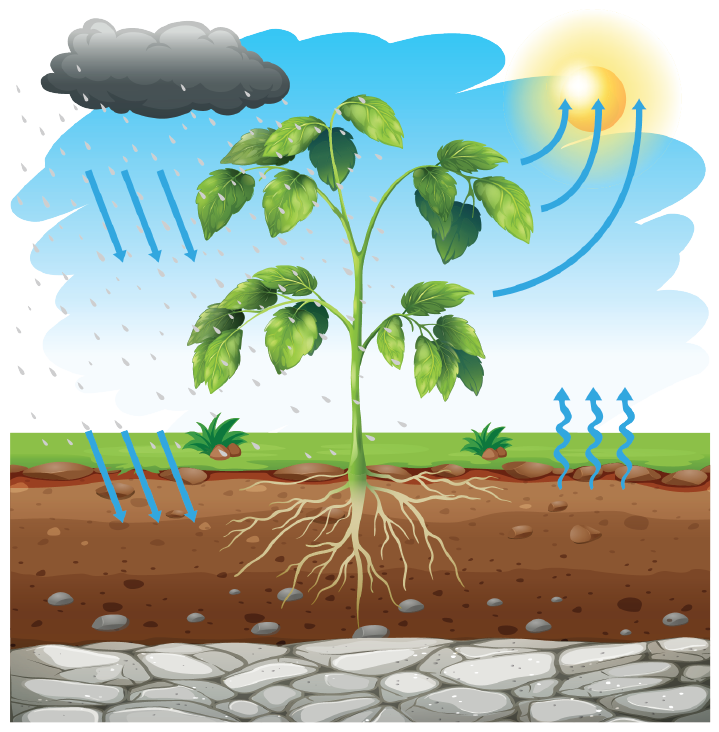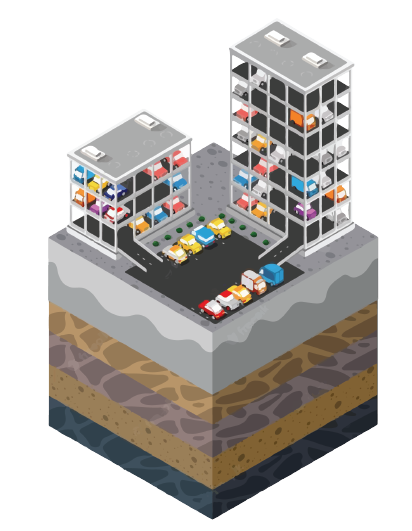Contents of this page
Soil functions
Soil is much more than just the top layer of the earth. Find out why!

Soil is one of the most important bases of life for humans, animals, and plants. Without soil, life on earth, as we know it, could not exist. Soil has a wide variety of functions. It provides habitat, regulates the balance of energy, water, and material, and filters water. People use soil for production which provides for society. Soil functions like a storage facility, a repository of information and has cultural significance.
BENEFITS FOR GREEN COOL SCHOOLS

- Identify areas on the school premises, that would allow for a “greener” design.
- What areas at school or in the neighbourhood could be unsealed to provide more green space? At the very least, start dreaming and communicate it.
- What areas could be used for joint greening activities? Think about greening possibilities that would work on sealed ground as well.
- Tip: give some thought to the roof and the facade of the school as well!
Habitat functions
Soil is a habitat and ecosystem. A variety of animals, plants, organisms and, of course, humans live in and on the soil. On the one hand, different soil types provide the basis for the development of different habitats, on the other hand, the soil itself is a habitat. A wide variety of soil organisms can break down organic pollutants or loosen the soil. But above all, as a whole, they form an essential part of the soil, which is available to us as a basis for life.
Soil stores nutrients, such as phosphorus or nitrogen, or converts them into other nutrients that plants, animals, and soil organisms need to sustain life. Humans, in turn, live off plants and animals. Consequently, soil is the basis for human nutrition.

Regulatory function in the natural balance
Soil plays an essential role in the water cycle. When it rains, it stores the water so that less water is fed into the so-called surface water (lakes, rivers, seas) and the danger of flooding is reduced, especially after heavy rainfall. Some of the water seeps into the ground and becomes groundwater (groundwater recharge). Another part is released to plants and enters the atmosphere through evaporation.

Filter function and buffer function
Soils can retain pollutants mechanically (filter) or bind them chemically (buffer). Depending on the soil properties, the soil can filter and buffer different amounts of pollutants. On the one hand, the retention of pollutants protects the quality of groundwater. On the other hand, the buffer capacity is limited, and it is not possible to store and bind an infinite number of pollutants. Pollutants then stored in the soil, can have negative effects on human health, if they get into food, for example. Carbon is also bound in the soil. The carbon bound helps to limit the greenhouse effect, which is partly caused by humans. Peatlands, in particular, absorb large amounts of CO2 and store carbon.
Archive functions
Soils can also tell us about the former uses and climatic development of a place.
- Cultural history: Soils do not even forget uses that date back more than 1,000 years. For example, the routes of old Roman roads are still clearly visible in aerial photographs despite today’s agricultural use of the same land.
- Natural history: Soils are witnesses to the development of the climate. The red laterite soils were formed under tropical climatic conditions. The fact that they occur in our latitudes is indicative of the tropical conditions that prevailed here about 15 million years ago.

Functions for human use
Soil provides humans with the basis for food production – directly through the cultivation of vegetables, fruit, cereals, etc. and indirectly through the cultivation of animal feed for meat and milk production. The agricultural use of soils has intensified greatly in recent decades due to the industrialisation of agriculture and the rising population figures. The consequences are overloaded soils that are damaged by nutrient removal and by the input of fertilisers and pesticides. Chemical agents disrupt the soil organisms that are necessary for healthy, productive soil.
Humans use soils to extract raw materials. Almost everything we can put our hands on comes directly or indirectly from the soil. The wood for our furniture grew in forest soil, the plastic for our ballpoint pens was extracted from petroleum, the fabric for our clothes comes from a cotton plant, and so on. In addition, soil is the location of houses, factories, recreational facilities, roads, and so on.
DID YOU KNOW?

Soil in the city
The term “urban soils” covers the soils of urban-industrial areas. Like the soils of fields, meadows and forests, urban soils are part of the soil cover, which is the outermost, thin, and sensitive skin of our earth.
Functions of urban soil
Soil fulfils many different functions in cities. Not all of them are recognisable at first glance. Large areas are used for housing, industry, and our mobility. For example, soil is consumed for roads and paths for driving and parking, cycling, and walking, and for underground and tram routes. Tunnels and underground car parks are often not visible at first glance, but they also take up space.
Urban soil is strongly influenced by humans. Due to intensive use, urban soils differ considerably from the soils of the surrounding countryside. Soils that have been used up for houses, roads or industrial sites are greatly altered. In city gardens or parks, on the other hand, the soil often has a similar structure to natural soil in the surrounding countryside. It often has a humus layer on the surface.

TIP

Let the pupils consider alternatives to asphalt and concrete surfaces in the open spaces at school or in the school environment.
- Which ground uses are primarily reflected in the school yard?
- What surfacing materials are found in the school yard or surrounding area? For example, is it sealed with asphalt or concrete, covered with natural stones, gravel or other material, overgrown with plants, or open and/or prone to erosion?
Walk the site with the pupils and discuss the features on site. Do the materials used as surfacing serve the purpose? Why were the materials chosen? What are their advantages and disadvantages? What are the alternatives to improve infiltration?
OPPORTUNITIES TO DEEPEN THE TOPIC ACROSS DISCIPLINES

As an interdisciplinary consolidation you can work on the following questions with the pupils:
- Which soil functions do you use at school or at home? In your free time?
- Which soil functions are particularly important for agriculture and thus for food production?
- Which soils are depleted and why?
- What role does the water cycle play for humans?
- Would it be possible for humans and animals to live on earth if there were no soil?
Experiments
Experiment: Mapping
The pupils document different areas and their uses in the school garden and / or the school area. They discuss the different functions that the soil fulfils in these areas and the uses that take place or could take place.


